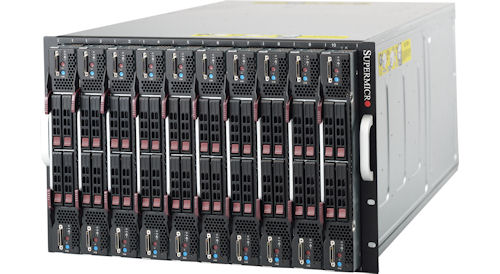Check Out SuperBlade Servers
Latest News
August 12, 2013
Dear Desktop Engineering Reader:
With people constantly demanding more performance for less expense, engineering IT managers sometimes must feel as cornered as that luckless florist with the people-eating plant in “Little Shop of Horrors” demanding more feed. On the one hand, they are under constant pressure from the pencil pushers to contain costs. On the other hand, engineering managers are constantly pressuring them for more performance to run ever more complex CAE and CAD applications quickly. This is what has led us so quickly to the world of HPC (high-performance computing) systems, virtual desktops, and the cloud. Each solution provides horsepower way beyond even the most tricked out individual workstation, and each offers varying degrees of cost-effectiveness compared to a company full of individual workstations.
 |
This is also where the beauty of blade servers comes into play. They’re powerful, flexible, and cost-effective compared to most standard rack-mounted servers. But, like engineering outfits, not all blade servers are the same. Some are as energy hungry as any rack-mounted server. Some seem to deploy with the idea that managing cables and other hardware should be as difficult as possible. Still others are really general-purpose business solutions. Many are all three. Today’s Check It Out link takes you over to Supermicro’s SuperBlade product line. You’re going to want to explore this. The SuperBlade product line-up seems engineered to handle compute-intensive HPC and data center jobs for high-end engineering work while conserving energy, being easy to manage, and technologically up-to-date.
The SuperBlade line begins with a 7U chassis that supports a variety of blade products for specific applications. Among the things to note here is that SuperBlade’s 19-in. rack enclosures tuck power, cooling, and networking gear in the rear of the chassis, optimizing space. Further, the enclosure simplifies cabling by gathering cabling for 10 blade modules at once, speeding up deployment and helping to reduce management headaches because there are fewer physical connections to troubleshoot. In terms of compute density, you can install 10 of the company’s TwinBlade models in a single 7U chassis. That’s 20 dual processor nodes.
To get an idea what this company has to offer, take the just announced 3x GPU SBI-7127RG3 and 2x GPU SBI-7127RG-E SuperBlades. These SuperBlades seem tailored for graphics-intensive applications ranging from CAE/CAD to cloud computing to virtual desktop infrastructure, they sport dual Intel Xeon E5-2600 series processors, and up to 3x GPUs (graphic processing units), up to 256GB memory, and onboard BMC (baseboard management controller) for IPMI (Intelligent Platform Management Interface) 2.0 support. The company says that 10x blades in a 7U SuperBlade enclosure scales to best density (180x GPUs and 120x CPUs) and performance (256 TFLOPS, theoretical) per 42U rack.
Supermicro’s TwinBlade series also has high-efficiency (94%+/-) 2500W or 3000W power supplies. Networking options such as up to two 4x FDR (56Gbps) InfiniBand switches or two 10GbE switches, and two 1GbE/10GbE switches, provide TwinBlade users the bandwidth for demanding virtual desktop infrastructure and engineering applications.
Supermicro also strives to keep on the cusp of the latest technologies. For example, the company recently announced support for the latest Intel Xeon processors with Intel’s MIC (many integrated core) architecture based on Intel Xeon Phi coprocessors in their 2x GPU Blade (SBI-7127RG-E), which should accelerate the performance of engineering, scientific, and research applications dramatically.
Still, after all the specs like density, nodes per rack, etc., it’s really that lower power consumption and reduced management time that makes Supermicro worth checking out. Management time is a little harder to quantify, but you can probably make a great guess of what it could mean to you just thinking of a world with fewer cables. Power conservation, however, is a different story. Supermicro says that one of its SuperBlade servers has the potential to save more than 100 watts over a traditional discrete 1U rack-mount server. Do the math. Then start checking out the SuperBlade server line from the link over there.
Thanks, Pal. – Lockwood
Anthony J. Lockwood
Editor at Large, Desktop Engineering
Subscribe to our FREE magazine, FREE email newsletters or both!
Latest News
About the Author
Anthony J. Lockwood is Digital Engineering’s founding editor. He is now retired. Contact him via [email protected].
Follow DE





